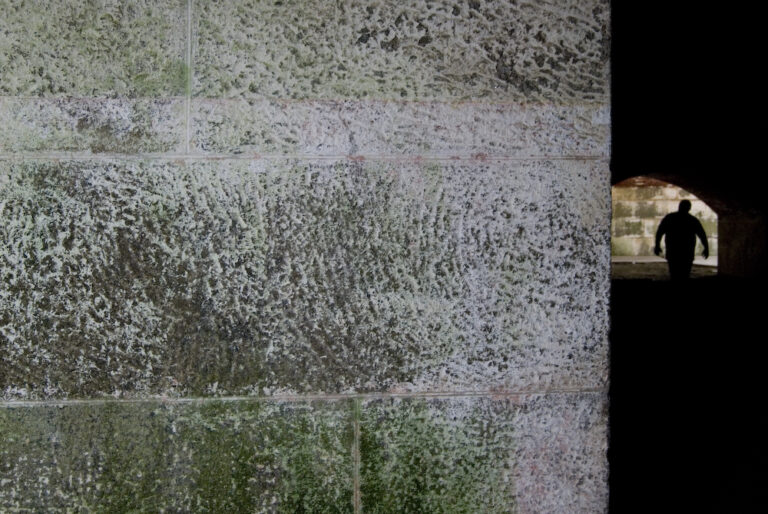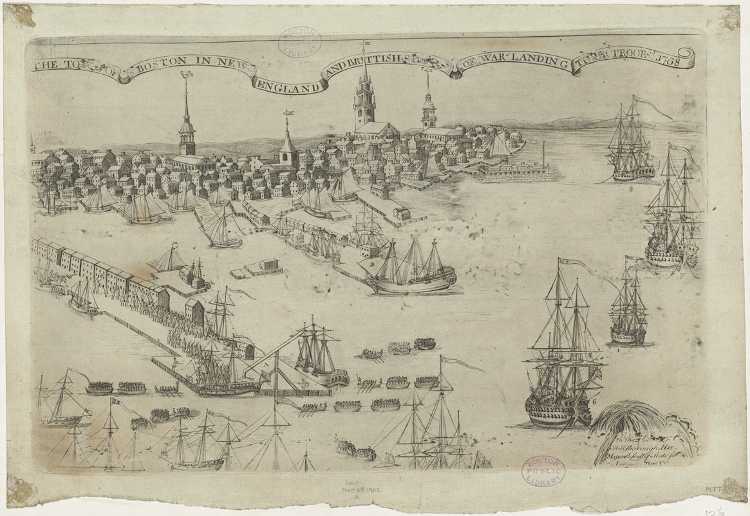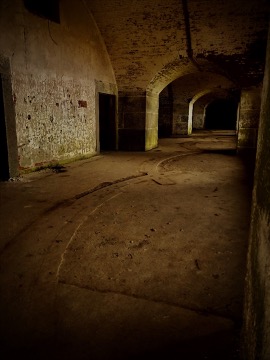October Ghost Stories

October is one of the best times to gather around the campfire and tell ghost stories. The Boston Harbor Islands are home to more than their fair share of ghost stories and haunting histories. In honor of this spooky time of year, we would like to highlight the most infamous of these spooky spirits: the ladies in red, black, and white.
Legend of The Lady in Red
In 1776, British forces evacuated the port of Boston after three years of occupation following the Boston Tea Party. Soldiers and sailors left on the British fleet, along with about one thousand Loyalists, who wished to remain under the rule of King George III.
But the British fleet did not have smooth sailing as they fled the city. Colonial forces under the command of General George Washington fired upon the departing ships using the cannons transferred from Fort Ticonderoga.
According to legend, the newly married Mary Burton, eager to begin her new life in England, was caught in the line of fire and struck by a cannonball. After suffering for several days, she passed away. When a temporary truce was established between colonial and British forces, she was wrapped in a red blanket and buried on Long Island in Boston Harbor. Her simple grave marker was soon reclaimed by the elements.
A few years later, local fishermen, and later the soldiers at Fort Strong, began reporting sightings of her ghost, clad in the red blanket, wandering the island. Long Island is currently unoccupied, so not recent sightings of Mary Burton have been recorded. Perhaps she still paces the island alone, longing for her husband and the life she could have had across the sea.

The town of Boston in New England and Brittish ships of war landing their troops! 1768
Image courtesy of Digital Commonwealth
Legend of The Lady in Black
During the Civil War, Fort Warren on Georges Island housed Union soldiers, as well as Confederate Prisoners of War. A young man named Samuel Lanier was among the captured Confederate soldiers. It was not uncommon for young recruits on either side of the war to marry their sweethearts before marching off to battle. The same was true for Samuel, who married his beloved Melanie only a few short weeks before being captured and sent to Boston. Somehow, Samuel successfully gave news to Melanie about his capture, along with directions on where he was being held. Together, the newlyweds plotted his escape from Fort Warren.
Melanie traveled north to the town of Hull, where she was sheltered by a Southern family. The Confederate sympathizers helped her procure a rowboat, a disguise of men’s clothing, and a pistol. With these preparations, Melanie rowed herself across the harbor to Georges Island under the cover of fog and darkness. She arrived on the island and wandered the perimeter of the fort, whistling a tune she and her husband had often sang together. Hearing the refrain whistled back, Melanie knew she had found her husband. She was pulled over the walls and into the room where Samuel was being held. Then they set to work tunnelling out. However, the couple was soon discovered by Union soldiers, and Colonel Dimick was notified. When confronted, Melanie made a desperate attempt to protect herself and her husband by firing at Colonel Dimick. A shot rang out, but Dimick still stood. Instead, Melanie’s husband, her beloved Samuel, lay dead. The pistol had misfired.
Wracked with grief, Melanie was arrested and tried as a spy. She was sentenced to death. Still disguised in men’s clothes, Melanie requested that if she must die, she should die with dignity in a dress. With very few women living on the island, the best that the soldiers could find were some old black robes, which Melanie wore to the gallows. Over the years, soldiers and visitors to the island have reported strange sightings of a woman in black robes, and footprints on the ground coming from nowhere and leading nowhere. Many believe that these are signs of The Lady in Black.

Image courtesy of NPS/Parsons
Legend of The Lady in White
In 1888, a community of Portuguese fishers moved from Long Island to Peddocks Island in Boston Harbor, bringing their families with them. One fisherman made the move with his young daughter. As the girl grew up, she became a very talented piano players, entertaining friends and family with her beautiful music. At the start of the First World War, the fishing village on Peddocks gained new neighbors: the 55th Regiment of Coastal Artillery Corps, which was stationed at Fort Andrews. Although there was usually limited contact between the soldiers and the islanders, but the fisherman’s daughter would visit the fort once a week to play piano. All of the soldiers loved the music, but one also fell in love with the musician. As time went on, the soldier and the girl became inseparable, and planned to marry after the war. However, in 1917, the 55th Coastal Artillery were sent to France and the couple was forced to say goodbye. While her love was away, the fisherman’s daughter read the paper each week to hear news about the war, anxiously waiting for his return. The war ended, but the man still had not returned to her on Peddocks Island. One day while reading the newspaper, she came across a wedding announcement with a familiar name. After two years of waiting, she learned that the enlisted man she loved had forgotten all about her, and married another woman in Europe.
In her grief, she ran to the fort and began playing the piano with a passion and emotion like never before. She played all the enlisted man’s favorite songs. She played songs full of sorrow, love, and loss. She played night and day without pause. She played until she died of grief and heartbreak.
At this point in time, between the wars, Fort Andrews was under caretaker status. There were no soldiers living in the fort. The woman died alone. Months, or perhaps years later, her body was found by the piano, wearing a wedding dress. Since then, many people visiting or living on Peddocks have reported hearing the haunting notes of a piano carried on the breeze—the sound of the Lady in White playing through the grief of her lost love.
If you visit the islands, then perhaps you too may encounter these infamous ghosts that haunt the harbor.

Image Courtesy of NPS
Bibiography:
Damstra, Kevin. Ghosts of Peddocks Island. 2003.
Snow, Edward Rowe. The Islands of Boston Harbor. New York: The Cornwall Press, 1971.